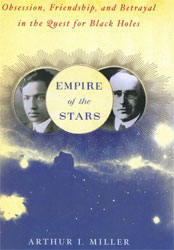
Subrahmanyan Chandrasekhar, or Chandra, was a child prodigy in India. Straight from excelling at undergraduate school in the depths of India, he entered the cool, damp climes of Cambridge University. With few compatriots and little experience in the ways of English university rapport, he tried his best to add something useful. Excelling in mathematics and wanting to make a mark, he entered into the relatively new field of astrophysics. In particular, he established a mathematical basis for the degeneration of stars. The problem, of course, was that on the death of too large a star, the math showed that a death-knell implosion would lead to an infinite amount of mass in a negligible volume. As physicists had accepted that nature abhors vacuums and infinites, no one supported Chandra’s results, even though they agreed with the mathematics. Only 40 years later, with advances in knowledge together with the detection of the signatures of black holes in space, did Chandra get vindicated. Though he lived to see this result, given the initial umbrage, especially from Sir Arthur Eddington, Chandra was less than pleased.
Bringing the human dimension into scientific discovery can be fascinating. Arthur Miller depicts this well on delivering his review of the reception of Chandra’s calculations for the degeneration of white dwarfs. Chandra was a ‘wet behind the ears’ new graduate who believed in the scientific method for establishing or disproving theories. Implying this, Miller then shows that Chandra met formidable and conjectural resistance from the accepted world expert and fellow Cambridge astrophysicist Sir Arthur Eddington. Miller recovers details from original documentation showing how Chandra had the verbal support from most if not all the preeminent practitioners of the field like Bohr, Dirac, and Pauli. But none wrote any support for Chandra, for concern, as Miller put it, of crossing Eddington.
As evidenced by over 50 pages of referenced material, Miller provides credible details of the happenings of 70 years ago. He was hampered in that the estate of Sir Arthur Eddington had long ago destroyed almost all his personal papers. Further, Chandra usually worked solo, so few others could provide descriptions of his character. Because of this, Miller dedicates only one chapter to Chandra, describing his early years, while another describes Eddington’s. Thus, he makes up for a lack of personal information by providing details on the many other people who kept filling in the puzzle regarding black holes. Often a page or two will give personal experiences, like Karl Schwarzschild’s time in the front lines, or Yakov Zel’dovich playing catch with a medicine ball. Sometimes he goes far afield by including anecdotes of commuters who took the long way to Los Alamos via a bar in Mexico. However, these snippets add pleasant colour to this historical synopsis. As such, the centre of the book contains more a series of personalities and their contributions rather than relevance to Chandra and Eddington.
Because of this, Miller falls a bit flat on his original postulation that Eddington’s displeasure with Chandra’s presentation in 1935 held the field of astrophysics back for 40 years. Rather, Miller, in later chapters, indicates that Chandra maintained a voluminous production of highly regarded mathematics, garnering most of the top awards which cumulated in a Nobel prize. Further, Miller shows a steady progress in astrophysics. That is, though Chandra’s mathematical speculations weren’t accepted, experimenters kept advancing our understanding. It seems Miller joined two ideas into one book. One examines the interaction between Eddington and Chandra. The other reviews the chronological steps in astrophysics, particularly regarding star degeneration. The sum is a personable history of late twentieth century astrophysics with particular emphasis on two early contributors.
Some people naturally have gifts that lend themselves to scientific explanation. However, people come with a complete suite of less than stellar personalities. As such, theorists can have a really rough time until practitioners catch up. Arthur Miller in Empire of the Stars describes the trying time of Subrahmanyan Chandrasekhar who believed in black holes long before any evidence arose. But Miller shows how experimenters did catch up to this theorist who was looking so far ahead of most everyone else.
Review by Mark Mortimer
Read more reviews online, or purchase a copy from Amazon.com.
